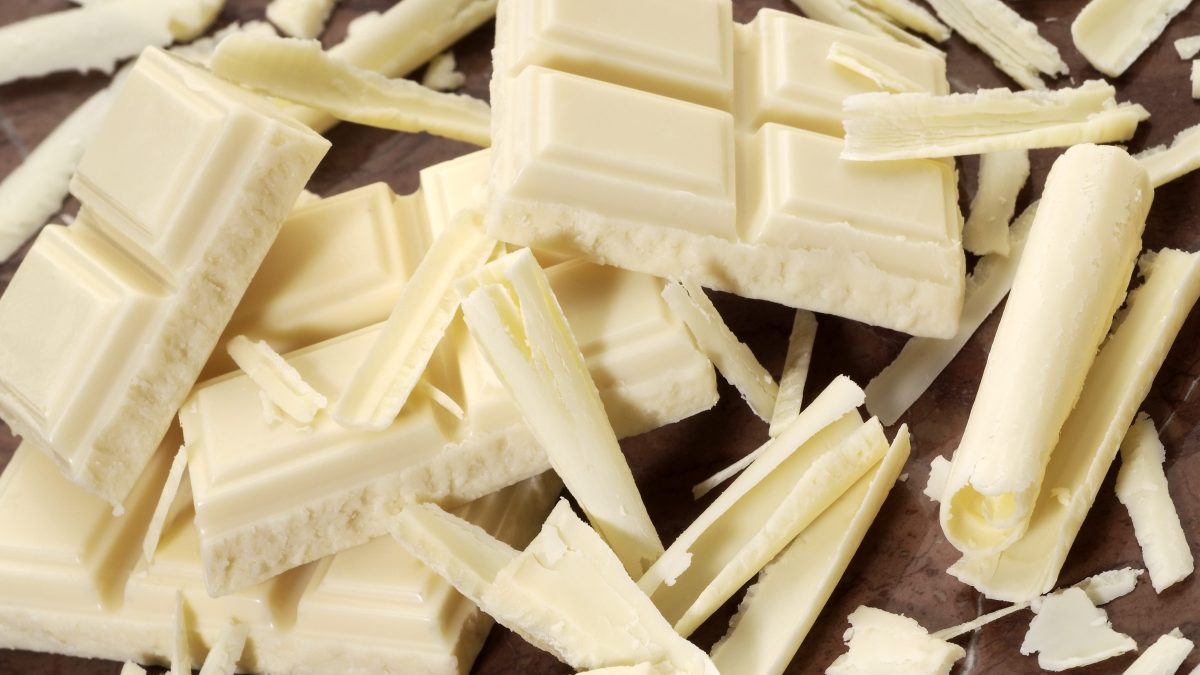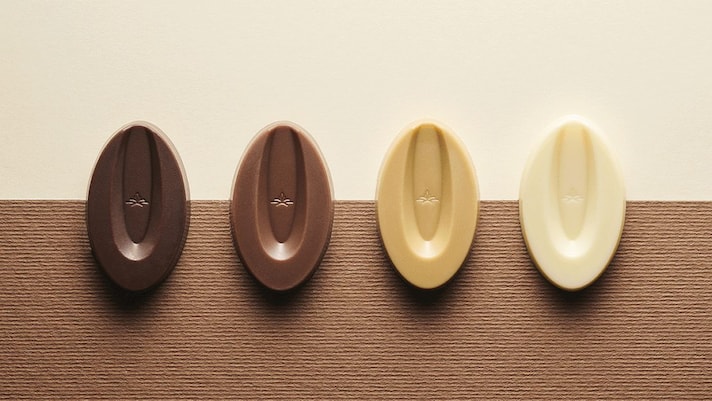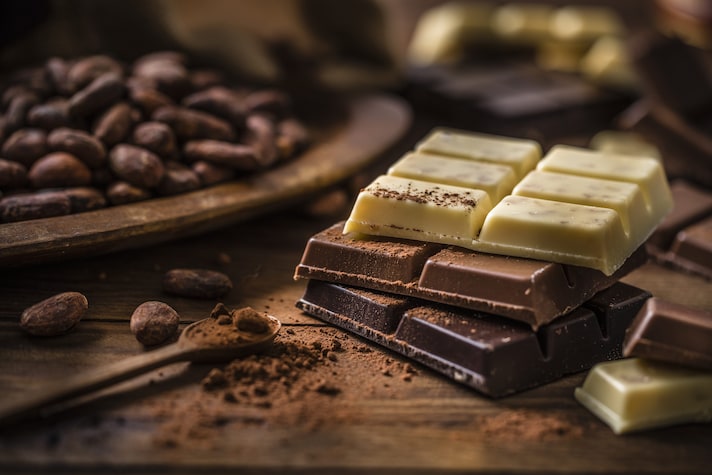
While chocolate, whether dark or milk, always manages to unite everyone, the same cannot be said for white chocolate. Often mistreated, often considered much higher in calories and less valuable than its more beloved siblings, the white variety fully belongs to what, by law, is defined as chocolate. To dispel some myths and restore some dignity to this wonderful product, we asked Franco Ascari, Master Chocolatier at Valrhona, what it is and what ingredients it is composed of.
What is White Chocolate?
Before trying to revive the good name of white chocolate, let's start with the basics: what is it? It's simple, three basic ingredients and two more technical ones, so to speak: white chocolate "is a product composed of a mixture of cocoa butter, sugar (usually sucrose), and powdered milk. Other ingredients can also be found, such as natural vanilla extract, but also ingredients like lecithin," explains Ascari. And before the word lecithin scares you, let's clarify that it's simply a thickener used to "improve rheology, or the fluidity of the product," and today sunflower lecithin is primarily used.
But going into the specifics of the ingredients, it is also worth making a clarification on the powdered milk which should be "whole, i.e. with 26% fat": this is because a good powdered milk, with a decent percentage of fat, has a richer flavor and, consequently, will give a stronger taste to the chocolate.

Cocoa Butter is Not Just Better
Let's now move on to one of the most divisive topics of all time: cocoa butter. If you're among those who cry foul because "white chocolate isn't chocolate because it's made with butter!" put down your torches and pitchforks and let us explain in a moment why this isn't the case. The butter used in white chocolate isn't the classic butter we use at home, but, we repeat, cocoa butter, which is "naturally contained in cocoa beans, which are the raw material from which everything related to the world of chocolate begins."
And now let's take a step back to better understand where chocolate comes from. As we already know, and we'll say it for those who don't yet, the process that leads to the creation of chocolate (dark, milk, or white) starts with cocoa beans, which undergo a grinding process to obtain "the cocoa mass – also known as cocoa paste or cocoa liquor – which contains approximately 53-54% cocoa butter," Ascari explains. This semi-finished product is then subjected to a subsequent pressing process, which occurs through "very complex systems that use mechanical pressure to separate the fat, i.e., cocoa butter, from the remaining part, i.e., all the dry cocoa extract which also contains the fiber."
This is how we obtain cocoa butter, which is used in all types of chocolate, not just white chocolate. For this reason, after the pressing process, "a subsequent decantation phase occurs, in which the butter loses all residual impurities and is deodorized, meaning it becomes completely neutral in taste. This is because," Ascari continues, "cocoa butter, in dark and milk chocolates, is added to make the product more fluid, but it must not interfere with the aromas of the other ingredients. Therefore, the taste neutralization serves to leave room, aromatically and taste-wise, for the other elements we are using." So no, white chocolate is not an impostor but is simply made with a different base product than the others, but which is still derived from cocoa beans.
Why Is White Chocolate White?
"It's true that chocolate is used as an ingredient in many recipes, but it's also true that chocolate is a recipe itself," Maestro Ascari told us. This means that, like any good recipe, it has ingredients and a preparation method to follow. This time, let's flash forward a bit and start at the end, with a question that might seem obvious, but, as Socrates would say, "the wise man is he who knows that he knows nothing." Fortunately, every question is always justified by great Greek philosophy: why is white chocolate white? Anyone who knows a little about chocolate basics might already know this, but if not, Ascari explains: "The huge difference between white chocolate and other types is that, in the former, of all the ingredients we can extract from cocoa beans, there's only the fat, so all the dry matter and fiber, which is also what gives chocolate its color, is missing . This is why," the maestro continues, "white chocolate has a color that we wouldn't associate with chocolate, because it contains cocoa butter—which has a whitish color—as the only ingredient derived from the beans."

How to Get It
Having made this brief introduction, let's now delve into the specifics, trying to understand how it is processed: the base is, in fact, cocoa butter, previously deodorized, to which " the other ingredients are added, therefore sugar – usually sucrose – powdered milk and any other ingredients such as lecithin and vanilla extract. The latter two – Ascari specifies – are however added in very low percentages: lecithin is added at 0.4% of the total product, while vanilla extract is a whopping 0.02%. Then, once all the ingredients are combined, they "are refined in order to obtain the finest possible grain size" before moving on to the conching phase, which consists of "heating and mixing the product once all the ingredients are already present". This step is particularly important for dark and milk chocolates because the dry fraction derived from the cocoa beans, and contained within them, carries "a certain amount of acetic acid, which is a residue from the fermentation phase —one of the processing steps still carried out on the plantation—and is a volatile molecule: conching allows these molecules to disperse, thus reducing the acidity of the product." But, as we've repeated quite a few times already, and we'll do it again so we never forget, white chocolate doesn't contain any dry fraction, so "this acidity isn't found; nevertheless, even for its preparation, the conching phase is important because it gives the product a greater silkiness and finesse."
"White Chocolate is More Caloric Than Dark Chocolate"
So: we probably know we're dealing a huge blow to those who are on a weight-loss diet and indulge in a little piece of dark chocolate in the evening without feeling guilty because "it won't make you gain weight." But, for the sake of intellectual honesty, every now and then we have to shatter some dreams and tell you that no, it's not true that dark chocolate is the lowest-calorie chocolate: the difference lies in the percentage of sugars and fats it contains, because "in a high-percentage dark chocolate, it's true that there's very little added sugar, but it's also true that there's a high percentage of fat. Therefore," says Ascari, "dark chocolate isn't necessarily more diet-friendly than white chocolate, because the former might have less sugar than the latter but be higher in calories overall."
The health benefits of dark chocolate have been well-proven , but if you're looking for a guilty pleasure to indulge in every now and then that doesn't contain too many calories, our advice, and that of Franco Ascari, is to "read the label, which is obviously the only way to understand the calorie intake."

White, Ivory, Yellowish: What Color Should a Good White Chocolate Be?
Very often we fall into the mistake of believing that if a chocolate is "too white" it must be the result of some strange process or chemical ingredient: in reality, for this type of chocolate "there is no reference standard, unlike other types, where you can rely on a color palette to understand if that chocolate, for example, has been overroasted." As for white chocolate, if it appears a little more ivory- like, it's probably because the type of milk powder used, in combination with the cocoa butter, has given it that color; similarly, if it appears particularly white, it means we are dealing with "a chocolate richer in milk powder and a little less in sugars": in any case, obviously, this doesn't mean that one is better than the other, but rather that they simply follow different recipes.
Another variable is the conching phase we mentioned earlier: this is because during this phase, "where the chocolate is heated for a certain period of time, there may be a slight caramelization of the sugars—both sucrose and milk sugar, i.e., lactose —which would lead to that slightly yellowish note caused by caramelization, which, however, shouldn't occur. This happens when the chocolate isn't conched very expertly, giving it a cooked milk or slightly biscuity aroma." However, even in this case, it's not a question of poor- quality chocolate, but simply a slight error during processing. So, in essence: "The color of white chocolate doesn't determine the quality of a chocolate and is therefore not as stringent a parameter as it is with milk or dark chocolate."
Pay Attention to the Preservation Method
While color isn't indicative of quality, it can be indicative of the preservation method, and in this regard, Maestro Ascari gives us some little advice for recognizing poorly preserved chocolate: "If it doesn't have a uniform color, but has white streaks or dots, it means that cocoa butter has surfacing, a defect that can manifest itself over time if the chocolate has been stored in a place that's too hot or too humid."
How to Choose a Good White Chocolate
The answer to this question, for all foods, is always the same: read the label. The only way to be a careful and informed consumer is to always consult the list of ingredients to understand what you're buying. But in the case of white chocolate, what should you pay attention to?"A good white chocolate must be made with cocoa butter and not with any other fats," says Ascari, even though the law says otherwise. In fact, "at the European level, it's possible to call products that contain vegetable fats other than cocoa butter ‘chocolate'," but his advice is to be wary of this type of chocolate and choose one that contains only cocoa butter and "full-fat milk powder , because it's tastier and richer." As for flavorings, however, the important thing is that they aren't synthetic: so " natural vanilla flavoring yes, vanillin no."
While all we can do when we go to buy a product is read the label, once we've purchased it, our judgment is reserved for the palate. As for white chocolate, "one of the biggest flaws in terms of taste is the scratchy feel and tingling sensation on the palate, a sensation that comes from using a poor-quality powdered milk, and therefore indicates that we're dealing with a white chocolate of questionable quality."

So It Is Less Valuable Than The Others?
If the point was made clear, now you too can answer this question: no, it is no less valuable. For the master chocolatier, "whoever says white chocolate isn't chocolate is simply expressing their own taste opinion": it is, in fact, a chocolate and, as such, by law, must meet certain parameters. If we are faced with a white chocolate that contains "20% cocoa butter, 14% dry matter derived from milk powder and a minimum of 3.5% milk fats," it means we are dealing with a product that fully falls into the "chocolate" category.
The white variety certainly offers less of a palate-pleasing experience than the other two, and this is because "an important component of the cocoa bean (i.e., the dry matter) is removed, but that doesn't mean it's not a chocolate." And precisely because it's less aromatically complex, it actually makes it extremely versatile, making it "one of the most popular products among pastry chefs, as it can be easily paired with a multitude of ingredients, which it supports."
;Resize,width=767;)
